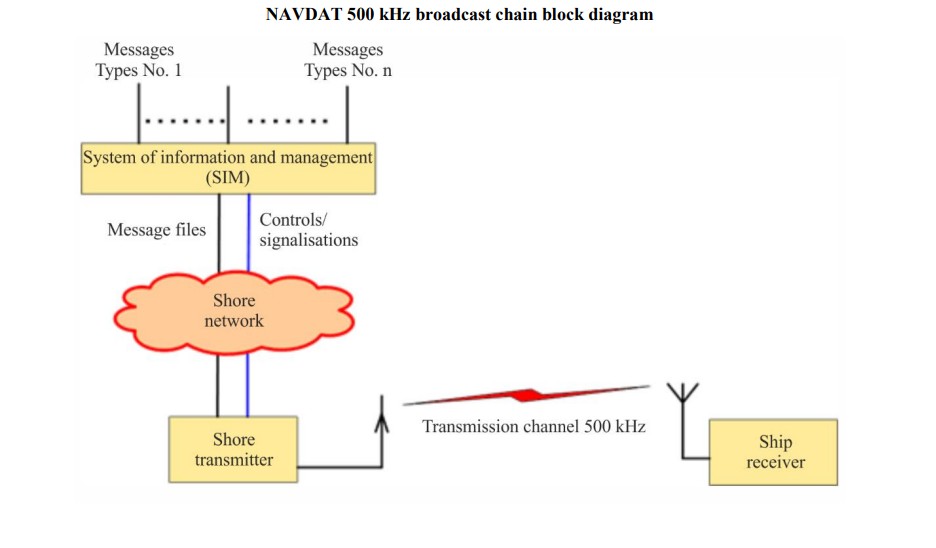Do you know what the NAVDAT system onboard ships is?
The NAVDAT (Navigational Data) system is designed to broadcast digital messages to ships at sea using both Medium Frequency (MF) and High Frequency (HF) bands. Specifically, it operates on the 500 kHz frequency in the MF band and the 4226 kHz frequency in the HF band, along with other maritime frequencies allocated for NAVDAT use.
NAVDAT supports the transmission of various types of data, including text, images, and other digital files, providing a modern digital alternative to traditional systems like NAVTEX. The NAVDAT receiver equipment should comprise a radio receiver, an appropriate antenna, a signal processor with non-volatile memory, a human-machine interface, data interfaces and an integrated display; or a connection to external equipment with a display (e.g. an integrated navigation system).
On 6 December 2024, the Maritime Safety Committee of the International Maritime Organization, at its 109th session, adopted Resolution MSC.569(109), which establishes the Performance Standards for NAVDAT.
These standards define the required capabilities of NAVDAT receiver equipment, which must be able to receive maritime safety and search and rescue information transmitted over MF and HF frequencies. Such equipment may be used to comply with the requirements of SOLAS Regulation IV/7.1.4.
The NAVDAT system is organized upon five vectors performing the following functions:
#1 System of information and management (SIM):
• collects and controls all kinds of information;
• creates message files to be transmitted;
• creates transmitting programme according to message files priority and need of repetition;
• monitors the operating status and broadcast quality of the shore transmitter;
• controls the operating parameters of shore transmitter.
#2 Shore network:
• assures the transportation of the message files and monitor data from sources to the transmitters.
#3 Shore transmitter:
• receives the message files from SIM;
• translates message files to orthogonal frequency division multiplexing (OFDM) signal;
• transmits RF signal to the antenna for broadcast to ships;
• monitors operating status and reports to the SIM.
#4 Transmission channel:
• Transports the 500 kHz RF signal.
#5 Ship receiver:
• demodulates the RF OFDM signal;
• reconstructs the message files;
• sorts and makes the message files available for the dedicated equipment according to the message files applications, or displays the contents of the message files.

Recently, the Hong Kong Marine Department issued a circular to highlight the key details of the NAVDAT Performance Standards as set out in Resolution MSC.569(109). The Resolution claritifies that the NAVDAT receiver equipment should provide facilities to automatically update the ship’s position and the time at which the position was determined from a suitable electronic position-fixing aid which may be an integral part of the equipment. For equipment which does not have an integral position-fixing aid, such facilities should include a suitable interface conforming to the appropriate international standards.
When the NAVDAT receiver equipment has a dedicated antenna, it is recommended that the antenna be equipped with two outputs for sharing with another MF/HF receiver.
Controls and indicators
- Subject messages excluded by the operator from display should be readily available.
- When a message is received correctly or with errors, the equipment may be able to emit a corresponding short audio notification. In addition, a distinctive alert should be built into the receiver for messages with distress and urgency priority.
- The NAVDAT receiver equipment should be capable of displaying communication parameters, including received signal strength indication (RSSI), signal noise ratio (SNR) and bit error rate (BER).
- Each time a NAVDAT message is received, the NAVDAT receiver equipment should display, in plain text, the priority, subject message, coast station identity and number of the message.
- The NAVDAT receiver equipment should be able to configure parameters of data interfaces for communication with other ship equipment.
- The stored tables of the NAVDAT receiver equipment should be able to be updated by using either a data interface or reception of stored tables update messages.
- Human-machine interface, including the presentation of alerts, for the NAVDAT receiver equipment should be in accordance with the guidelines developed by the Organization.
Receiver
Frequency management
- The NAVDAT receiver should be capable of receiving transmissions on MF (500 kHz) and HF (4 226 kHz) channels simultaneously.
- The NAVDAT receiver should also be able to receive, via a scanning function, on at least one (or more) regional frequency allocated to NAVDAT in the MF and HF maritime bands.
- The NAVDAT receiver should demodulate signal(s) received on the MF channel 500 kHz and the HF channel 4 226 kHz simultaneously.
- The demodulated signal(s) received by scanning can be decoded simultaneously or non-simultaneously.
Scan function
To allow reception of transmissions on national or regional frequencies assigned to NAVDAT, the receiver should use a scan function on the following maritime frequency bands:
- the MF band from 415 kHz to 526.5 kHz (except 500 kHz);
- the channels assigned to NAVDAT in appendix 15 of the Radio Regulations: 6 337.5 kHz, 8 443 kHz, 12 663.5 kHz, 16 909.5 kHz and 22 450.5 kHz
(except 4 226 kHz); and - the frequency bands assigned to wideband digital transmissions in appendix 17 of the Radio Regulations in the bands 4, 6, 8, 12, 16 and 22 MHz.
Alert
- Upon receipt of new search and rescue related information messages with distress or urgency priority, the NAVDAT receiver equipment should give an alert, including information for decision-making.
- The position information contained in the messages with distress and urgency priorities should be automatically transmitted to other navigation equipment (e.g. ECDIS, ENC plotter).
- The NAVDAT receiver equipment should comply with the Performance standards for bridge alert management
DO YOU KNOW?: Read in this series
Content Original Link:
" target="_blank">









































































































































